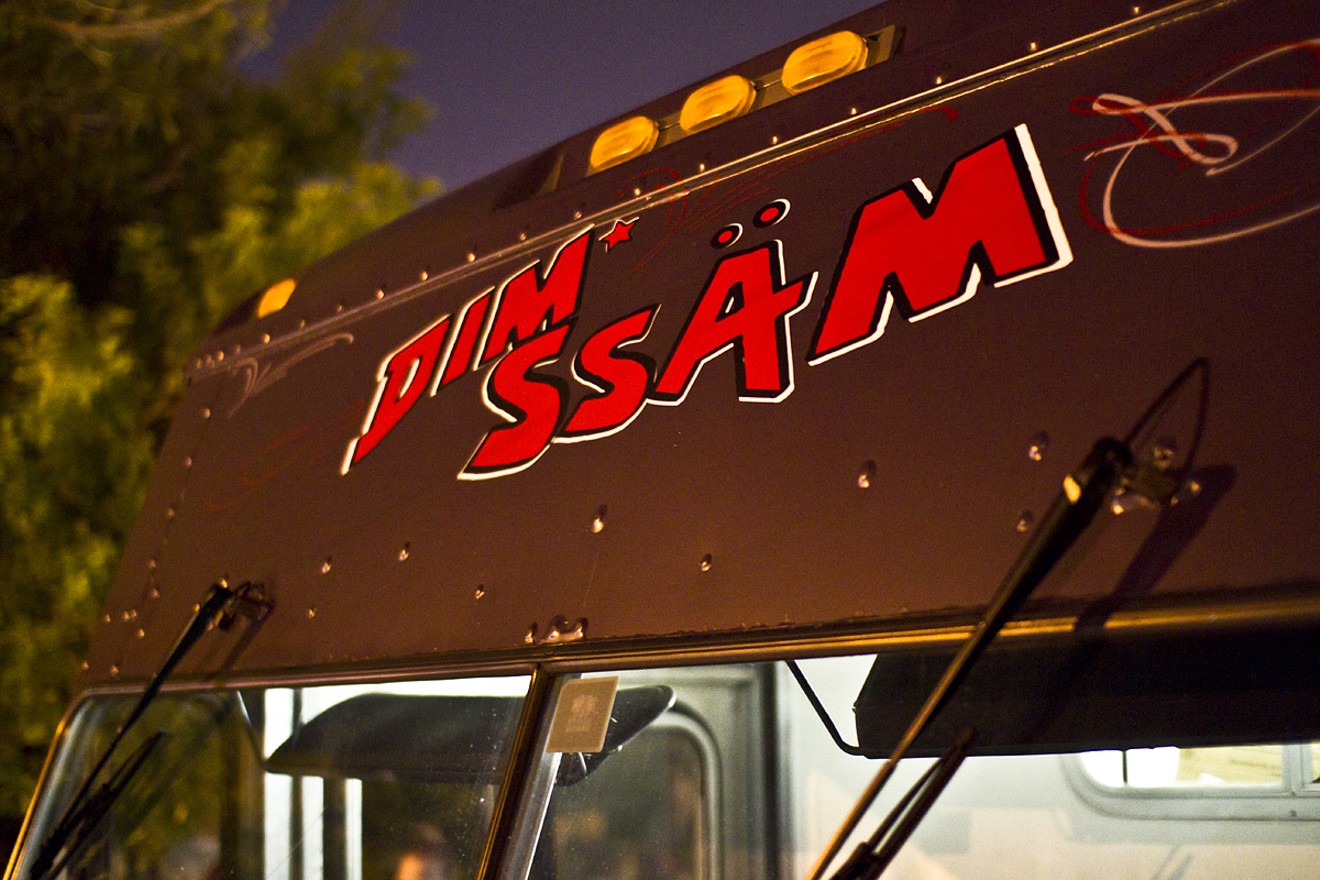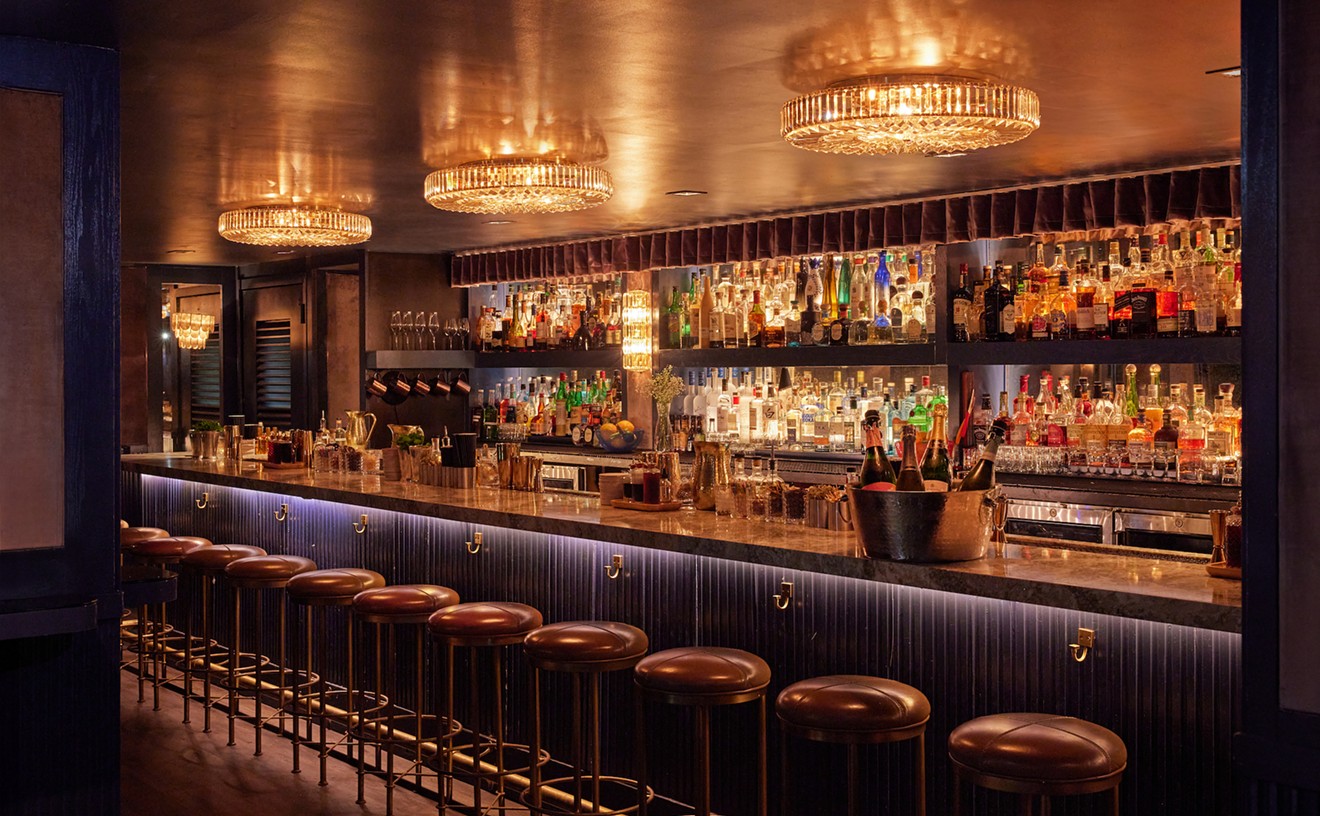On a recent steamy afternoon in Hollywood's Young Circle park, Chris Brown stands in front of a red truck painted with egg rolls, an American flag, and a Jamaican flag you can barely see because it's covered with hundreds of scraps of paper. Each is printed with a menu that includes a prodigious list of egg rolls. There's the Philly cheese steak, the corned beef and cabbage, the chicken and collard greens, even a Korean barbecue variety. The cost: two for $11.32.
"Get your egg rolls here!" Brown, who calls himself Chinaman, shouts like a carnival barker. "We have strawberry lemonade."
Brown's truck is one of a dozen parked here. All are trying to woo potential diners with colorful murals, bright lights, and menu boards. Some give out samples.
Nearby, on the northeast side of the park, a woman with a beagle orders chicken wings and a bottle of water at a truck called Wontons on Wheels. She's about a dollar short in cash, so co-owner Nick Biscoito throws in the water for free. The simple act of kindness is repaid when a line forms behind her. In an instant, a slow evening turns into a lucrative night with customers ordering wontons and shrimp burgers.
Biscoito says he launched the truck with partner Kyle HoiPong a year ago to get the word out about their food, which they hope to sell in stores. Hailing from Trinidad, the partners offer wontons filled with Caribbean flavors like jerk chicken and calypso shrimp ($10 to $12). Biscoito takes the truck out about three evenings per week. On a good night, he can make $500 to $600, but some days are a bust. Success is dictated by the crowd's taste and the weather. "If it rains, that's the end of it," he says. "The culinary world is a cutthroat business. You gotta hope you come out on top."
"Do you want to sit in a restaurant with good food and service or stand in a rocky vacant lot on broken glass?"
tweet this
Though Hollywood's food truck gathering still attracts a steady flow of families to the park, South Florida's food truck scene has waned. Roundups are smaller than they were a few years ago, with many attracting fewer than a dozen trucks. Crowds have dwindled too.
But the most significant — and longest-lasting — roundup is the monthly one at Magic City Casino (450 NW 37th Ave.) Sef Gonzalez started the gathering in the casino parking lot in 2011 when the Miami food truck craze was at its apex. In 2013, Gonzalez organized a parade in which 62 food trucks circled the casino in a 2.2-mile loop. That stunt, he says, got him a Guinness world record (which was later eclipsed by another, larger gathering).
Back then, Miami's food scene was vastly different. Trendy hotel restaurants and chains ruled, and there were few places where locals could get a chef-driven meal without breaking the bank. So some chefs turned to an alternative way of selling their product: food trucks.
Richard Hales had just opened Sakaya Kitchen in December 2009 when he decided to build a food truck. A graduate of the French Culinary Institute who worked with the venerable Jean-Georges Vongerichten, Hales fit the mold of the first wave of Miami food truck owners — creative chefs who wanted to jump on a budding culinary trend. Says Hales today: "I started to notice the food truck movement in New York. I thought it was pretty crazy. Then I started to see trucks like Latin Burger and GastroPod set up in Miami. I thought a truck would enhance what we were doing at Sakaya Kitchen."
Hales spared no expense on his Dim Ssam a Gogo truck. The $65,000 vehicle's interiorwas custom built by Food Cart USA to the chef's exact specifications. He commissioned tattoo artist Kat Von D to design the graphics and created a new menu that included a range of items from tater tots to Brussels sprouts.
Soon Hales organized the Second Saturday Wynwood Art Walk food truck roundup. It was easy to curate an event people wanted to attend. "At the time, I was the third or fourth food truck in Miami," he recalls. "Those were the days. It was such a cool, hot, new thing and there was a massive amount of exposure."
The first roundups featured mostly chef-driven trucks like Jeremiah Bullfrog's GastroPod, a shining retro 1962 Airstream; the Fish Box by the owners of Miami's La Camaronera restaurant; Jefe's Original Fish Taco; and Ms. Cheezious. Panther Coffee got its start by selling cold brew from a makeshift bicycle cart. Some roundups offered beer and wine.
Soon, Miami food truck owners found celebrity. They starred in shows like Cooking Channel's Eat Street and were featured on national television morning shows. Ms. Cheezious' Brian Mullins was flown to New York to compete in a network-sponsored event called "Live With Kelly and Michael's Truckin' Amazing Cook-Off."
Mullins likens what happened next to the California gold rush. "People were buying trucks who never worked in a restaurant," he says. "They thought a food truck was a cash machine on wheels."
The number of food trucks circulating throughout South Florida surged to about 200. They made as much as $2,000 per night at popular roundups.
Dim Ssam a Gogo's Hales says food trucks became victims of their own success. "People would go to the roundups and wait 45 minutes for some new truck's crappy food," he says. "No one's going to blame you if you stop going to food trucks because you got burned on high prices and bad food."
Miami's evolving food scene also negatively impacted food trucks. Says Hales, "In the past few years, there's been a restaurant explosion. Do you want to sit in a restaurant with good food and service or stand in a rocky vacant lot on broken glass?"
Today, you'll still see Dim Ssam a Gogo feeding movie and TV crews filming in Miami. Ms. Cheezious' truck — part of a business that now includes a Biscayne Boulevard restaurant — also heads out mostly for special events. "Back in the day, the truck would be packed like we were loaded for war," Mullins says. "It was me and some solid line cooks, and we could do $8,000 at Art Walk." These days, Mullins takes his truck out to events as a marketing tool to attract potential catering gigs. "It's not worth taking out the truck to make $1,500. We're popular enough that I have corporate clients. We've developed relationships with hotels on Miami Beach. I'm booked up with catered events through next year."
Food Halls have taken the place of food trucks. "The greatest thing about food trucks is that it got you out of your car and out of your bubble and into a communal atmosphere," says Hales. "That's exactly what's happening with food halls — and they're being curated with a better eye."













